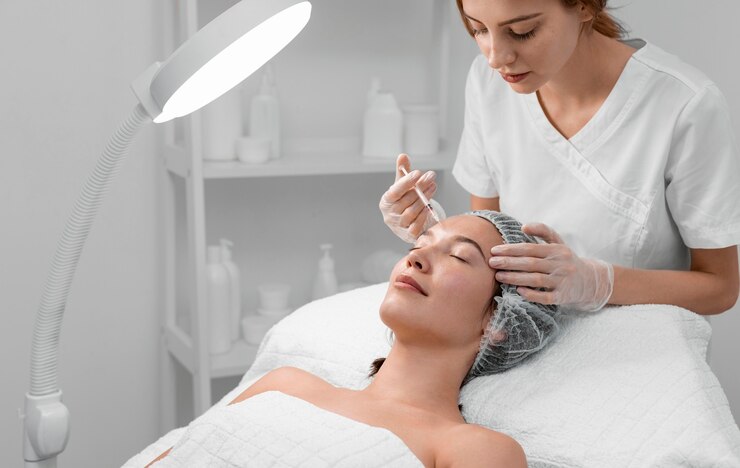Understanding Acne Scars and Pigmentation Issues
Before delving into treatments, it’s important to understand what acne scars and pigmentation issues are. Acne scars occur when a pimple or cyst causes damage to the skin’s deeper layers, leading to irregular tissue formation during the healing process. This can result in either raised scars (hypertrophic scars) or depressed scars (atrophic scars). On the other hand, pigmentation issues like dark spots, hyperpigmentation, or post-inflammatory hyperpigmentation (PIH) are usually caused by an overproduction of melanin after the skin has healed from an acne breakout. These spots may appear as brown or red patches on the skin.
How Aesthetic Treatments Can Help
Aesthetic treatments focus on improving skin texture, tone, and overall appearance by targeting the underlying causes of skin imperfections. For acne scars and pigmentation issues, these treatments can encourage skin regeneration, reduce pigmentation, and promote an even skin tone. Here are some of the most popular aesthetic treatments that can help:
1. Chemical Peels
Chemical peels involve applying a solution to the skin that exfoliates the surface layers, encouraging the skin to shed damaged skin cells and stimulate collagen production. Chemical peels can be particularly effective for both acne scars and pigmentation issues, especially mild to moderate cases.
- For Acne Scars: Chemical peels can help smooth out the skin’s texture, reducing the appearance of shallow scars and promoting collagen formation, which is essential for improving skin elasticity and firmness.
- For Pigmentation Issues: Peels can also target hyperpigmentation, as they encourage skin turnover and fade dark spots by removing the damaged layers of skin that contain excess melanin.
2. Microneedling
Microneedling is a procedure that uses tiny needles to create micro-injuries in the skin. This stimulates the body’s natural healing process, leading to the production of new collagen and elastin.
- For Acne Scars: Microneedling can be highly effective for treating both shallow and deep acne scars. The tiny punctures created by the needles help to break down scar tissue and promote the regeneration of smoother skin.
- For Pigmentation Issues: Microneedling can help reduce pigmentation problems by encouraging skin renewal and fading discoloration over time. It’s particularly useful for treating post-inflammatory hyperpigmentation (PIH), which is common after acne breakouts.
3. Laser Treatments
Laser treatments, including fractional laser and Q-switched laser, are powerful aesthetic treatments that can target both acne scars and pigmentation issues with precision.
- For Acne Scars: Fractional lasers work by delivering light energy to the skin, which penetrates deep into the layers, stimulating collagen production and improving the texture of the skin. This treatment is especially beneficial for atrophic scars, such as rolling and ice-pick scars.
- For Pigmentation Issues: Lasers can also target excess pigmentation, breaking up the dark spots and encouraging even skin tone. The Q-switched laser, in particular, is known for its ability to treat hyperpigmentation by targeting melanin and reducing the appearance of dark patches.
4. Dermal Fillers
For those with deeper acne scars, dermal fillers may be an effective option. These fillers, typically made of hyaluronic acid or other biocompatible substances, are injected into the skin to add volume and smooth out uneven textures.
- For Acne Scars: Dermal fillers work by filling in depressed scars, such as ice-pick scars or boxcar scars, creating a smoother skin surface. This temporary solution helps to improve the appearance of scars, and while the effects are not permanent, they can last for several months.
5. PRP (Platelet-Rich Plasma) Therapy
PRP therapy uses the patient’s own blood to extract platelet-rich plasma, which is then injected into the skin. The growth factors in the plasma can stimulate collagen production and help with the healing process.
- For Acne Scars: PRP can enhance skin regeneration, making it particularly useful for reducing the appearance of acne scars by promoting smoother, firmer skin over time.
- For Pigmentation Issues: PRP therapy can also help in evening out pigmentation by promoting healthy skin turnover and fading discoloration.
Conclusion
Aesthetic treatments offer promising solutions for acne scars and pigmentation issues. Chemical peels, microneedling, laser treatments, dermal fillers, and PRP therapy can all help in reducing the appearance of scars and pigmentation, improving skin texture, and promoting a more even skin tone. However, the effectiveness of these treatments can vary depending on the severity of the scars or pigmentation issues, as well as the individual’s skin type and response to treatment.
Before opting for any aesthetic treatment, it is important to consult with a qualified dermatologist or aesthetic professional. They can assess your skin’s specific needs and recommend the most suitable treatment plan to help you achieve the best results. learn more here – https://www.revitallab.co.uk/
